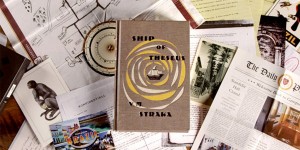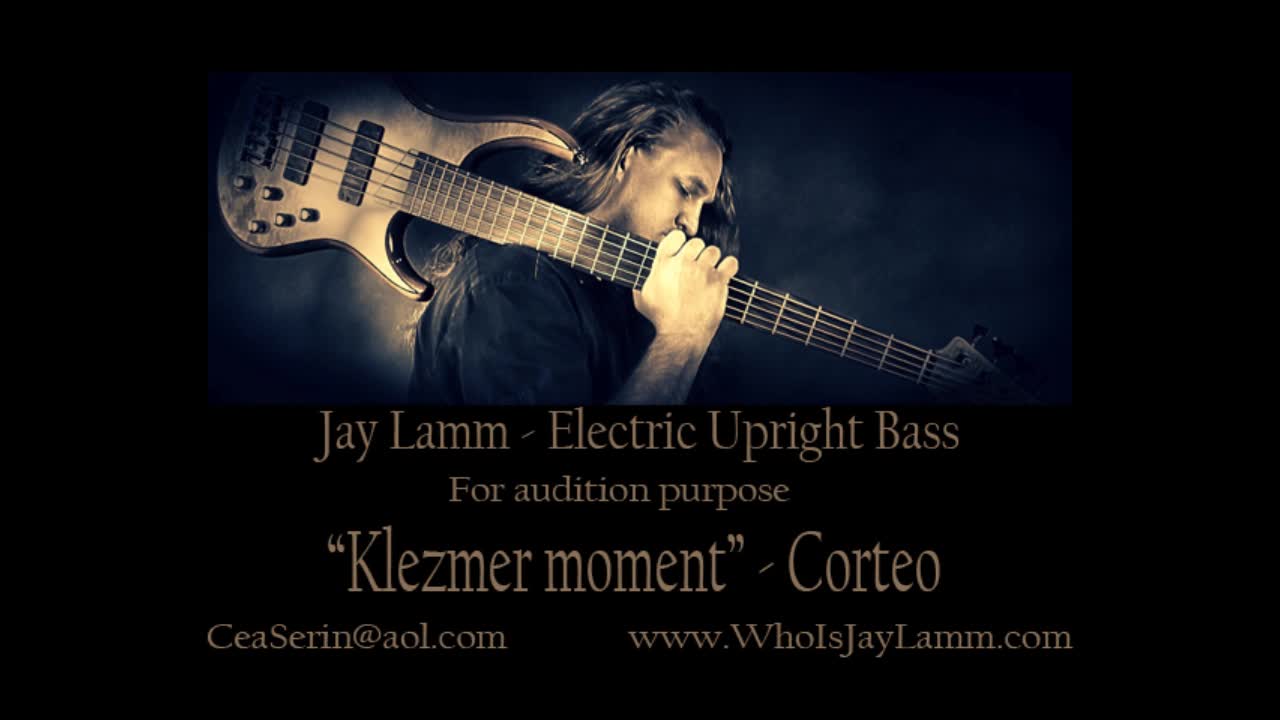Imagine that you’re at a bar with some friends and one of them has a story they want to tell. “You guys won’t believe what happened to me last night.” Great, some entertainment for the night. Your buddy starts telling his story and just as he gets into it two of your friends stop him mid sentence and ask him a question to clarify something. So your buddy obliges, clears up the question and then starts up with the story again. Again, two of your other friends pipe in and interrupt. Alright, this is getting a bit rude. Just let the guy tell his story! This story/interruption exchange then goes on for over an hour. When your buddy finally wraps up his story you can’t help but feel like you don’t really have a firm grasp on the actual thick of what happened to him.
That’s pretty much how you’ll feel after reading J.J. Abrams and Doug Dorst’s new book “S.”
I’m going to cover my hatred of this book in depth. I’ll try not to give out any big plot twists (there are none) or any key story developments (again, there are none). So by the end if I still haven’t dissuaded you from buying this enormous waste of time and printing supplies you’ll still be surprised at how bad it is for yourself.
Alright, so S. is based on a gimmick that it is a book within a book with neat little artifacts shoved between the pages for you to discover throughout. I can’t get into the actual book itself before I cover all the details of what separates this book from other books you’ll find on the shelf. S. comes in a 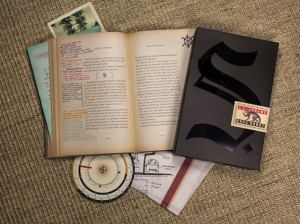 slipcase and wrapped in plastic. When you unwrap your purchase and take out the book inside you’ll see that the book looks like it came from a school library. The pages are weathered and stained and there’s a Dewey Decimal System number on the spine. By flipping through the pages you’ll see that it appears as if someone has put in clues, pictures, clues, messages, postcards, and all other kinds of artifacts. There’s tons of scribbled notes all along the margins also. And that’s the selling point of S. – that it is something you have to really buy a physical copy of to get into. How this is available in an audio format and on an ereader is lost to me.
slipcase and wrapped in plastic. When you unwrap your purchase and take out the book inside you’ll see that the book looks like it came from a school library. The pages are weathered and stained and there’s a Dewey Decimal System number on the spine. By flipping through the pages you’ll see that it appears as if someone has put in clues, pictures, clues, messages, postcards, and all other kinds of artifacts. There’s tons of scribbled notes all along the margins also. And that’s the selling point of S. – that it is something you have to really buy a physical copy of to get into. How this is available in an audio format and on an ereader is lost to me.
S. is the thing you buy. It’s the experience you go through. But what it all comes down to is that you’re actually reading a book called Ship of Theseus by a made-up author named V.M. Straka. But in reality you’re actually reading three stories. Here’s the deal on this:
J.J. Abrams conceived this project and Doug Dorst wrote it. The idea is spawned from the Shakespeare authorship controversy, or conspiracy theory I should say, as well as how one of them found a book on a bench one day with the hand written note of “pass this book along” inside it. Combine the two and there you go. Alright, so it’s like you’re reading a book that was passed back-and-forth between two college students who are trying to figure out who really was V.M. Straka and they’re sharing notes and documents and the book is acting like a type of FTP site for them. They’re both obsessed with Straka’s books and the lure of finding out more information about the mysterious writer.
Like I said, there is actually three stories going on here. 1) You’re reading Ship of Theseus which is the “final book by the mysterious V.M. Straka.” It’s about an amnesiac Stranger named S. who is struggling to find out who he really is. In the process he comes upon opposition to this shadowy group led by an insidious character that basically wants to do away with everything of substance. He wants to peddle mediocrity because with mediocrity he can control things. 2) You’re reading between the lines of the story in the book because there is also the account that surrounds its inception and clues cleverly placed within it that deals with the “real” life of the author himself and his translator. As it turns out this final book closely shadows his turmoils through his life as he deals with a shadowy organization called the S. This organization wants to do away with him and anyone involved. The authors life, the struggles of his translator, the mystery surrounding the death of the author, and the faces behind the S. are all veiled within the text of Ship of Theseus. 3) ALSO, while you read the book you’re reading notes written in the margins of the book by two college students that are trying to figure out the real story behind V.M. Straka’s death, who he really was, what’s behind the S., and you also follow these two kids as they fall in love and deal with the outside pressures bearing down on them as they get closer to the truth. Turns out they have to go through some similar ordeals that Straka and the character of S. had to go through in both the author’s supposed real life and the character’s life in the book even though some of these predicaments they find themselves in may very well be blown out of proportion.
There are a couple of things I actually liked about the experience. First of all, I think the printing was top notch. As silly as that sounds I just think that the pictures, documents, the staining of the pages, all that stuff that you get with the package was very well done. And for the price you pay, about 35 bucks, it’s actually a good deal. Thanks, China. Also, the idea behind all this is pretty cool. I mean, everything I said so far sounds really fun, right? You get to read this book and sort of eavesdrop on these two people as they uncover the mysteries of this author, his real life, and how it relates to the text. And then they get in trouble themselves. Oh wow!
No, you won’t come away with any of that feeling.
This is the literary attempt at something like ABC’s Lost. And like Lost, it’s rife with problems and an unsatisfying ending.
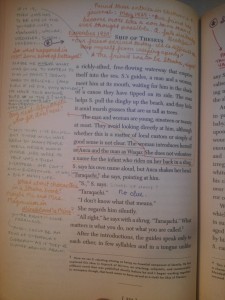
The first batch of problems that you’re going to be presented with is the clutter of the text in the margins. There are two people talking back and forth with each other in the margins named Jen and Eric. Jen writes in cursive and Eric writes in all caps print. So, it’s easy to tell who’s who. The problem is that the notes in the margins can get so cluttered and bunched together that it becomes enormously frustrating to try and navigate what should be read first. There’s also so many margin notes that going back and forth between the stories is tedious. It’s so easy to lose your rhythm of what’s going on. On top of that, all the margin notes are written at different times. As you read you can tell that Eric made the first batch of notes in pencil way before Jen ever came along. Then Jen finds the book one day and started writing her questions and responses in blue pen. She turns the book in, Eric goes to it again, he adds his own rebuttals, and so on. Soon you’ll see that these two have done multiple passes through the book and the instances of times of when it was done can be seen by the different ink types. For example, they’ll start off with blue and black ink, a second pass through they start writing in yellow and green, later on again when things have developed and more research is done they’re writing in red and black…and so on.

“What? He’s so totally a dude.”
Sometimes these little margin notes are so messy and small that they’re actually trying to write in between the sentences on the page. F’s look like S’s; T’s look like L’s – all made worse when it’s by Jen who writes in cursive. Usually an underlined passage means for you to read a margin note to the side which corresponds to the same colored ink, but then they’ll run out of room and leave a little asterisk for you to follow on another page. It can be enraging at times. And it’s constant. Nine-nine percent of the pages have these margin notes in varying degrees and some pages are just littered with them. That would be somewhat ok if these margin notes were furthering the story. But instead the notes seem like they were written by two potheads having a conspiracy theory debate.
Sometimes the margin notes are just stupid.
“Heh, this reminds me of you.”
“[- -]” <—which means eye rolling.
Hey, thanks for breaking away from the story YET AGAIN for more inane babble.
As you go through the book you come across little items that Jen and Eric leave for each other in their research. Sometimes it works; most of the time it doesn’t work. One time Jen said, “did you see this S on the wall I found” and enclosed is a picture of what she’s talking about. In cases like this the extra items work – it doesn’t help the story, it’s just cool. But sometimes there will be this card with no explanation provided. Most of the time you just have to piece it together. There will be postcards and after you read them you’ll know who they’re from and what the coded messages mean. Sometimes they’ll say, “I found a picture of everyone standing together. One of them has their back turned. I bet that’s _______.” But then no picture is provided.
But really it all comes down to the fact that all this shit shoved in between the pages is just fucking annoying. Yeah, it sounds neat but after having to deal with trying to keep them in the right pages and not falling out as your read gets tiresome. They included this little code wheel. Oooooh. A code wheel. But then they don’t explain how to use it. However, it’s at the back of the book for some reason and it’s presence is brought at the beginning of the book. So unless the little wheel falls out of the back of the book you’ll have no idea it was there. You’ll also have no idea on how to use it. For me, the story was so dull and the characters were so uninteresting I had no desire to attempt to use any of these little devices to join in with the collaboration.
What am I supposed to do, sit there with this fucking code wheel and try to break a code that will be revealed 6 pages later? Alright, well then I don’t have to use the wheel. But then the rest of the chapters the clues aren’t revealed???? So I DO have to use it? What’s going on here? I don’t have time for this shit. And I can’t read this in the bathtub and risk all this potpourri of garbage to fall into the bath water. The story just doesn’t engage me enough to give two shits about any of the characters or their stupid conspiracy theories. It certainly doesn’t grip me to want to read it again. And in no way does it hold my interest enough to make me want to try and play along with your Da Vinci Code horseshit.
And that’s the true sin of this book. The story is so dull and uninteresting that I had no desire at all to try and follow the clues. Since the story within the actual Ship of Theseus book is a secret attempt to uncover the life of the author’s struggles while also mirroring the struggles of the two college students conversing in its margins, the actually plot and writing of Ship of Theseus has to shoehorn in these annoying devices to alert you to how, in fact, all the stories are connected. So the actual writing of the book itself suffers for the sake of the gimmick.
And this is no Joy Luck Club, a successful attempt at marrying multiple characters and story lines. If you were to read Ship of Theseus as a novel in itself you will be sorely disappointed. The story is plodding with little excitement, very little character development, character motivations change, and there is zero pay off. It’s only purpose is to try and reflect the missed opportunities and mistakes between the Straka character and his translator and how it relates to the two college students. But it’s messy and feels thrown together and made up on the spot.

As the narrative of the SoT book goes on you have to endure the most annoying aspect of the book: the extremely repetitive musings of Jen and Eric. These two go back and forth with the same…god damn…nonsense….over….and over…and over…and over…and over.
It’s fucking torture to sit through. Sometimes they’ll talk like two conspiracy theory potheads and sometimes they’ll talk like they’re in the Twilight novels. One of them will process their love for the other…in the book, mind you. They go on about how their relationship is going to work and how it won’t be like Straka’s mistakes. It all plays out like a stereotypical Rom-Com.
Think of every Romantic Comedy movie you’ve ever seen. That’s the interaction between Jen and Eric. Oh, when they start out they don’t like each other. No they don’t. That Eric is an asshole. That Jen is a little princess in love with pretty words. But then something happens and they both have to endure a struggle together. What comes next? They realize they should be together. Oh no, but then someone says or does something stupid. A rift happens and someone has to atone for it so they can be together at the end. UGHHHHH!
It’s every fucking rom-com ever written. It’s trite. It’s boring. It’s insulting.
They also don’t solve ANY of the mysteries brought up in the book. All they do is speculate over and over. “What about this guy….oh, what about this guy.” Shut up!
The book is rife with issues that are never resolved. There’s a saying that if you bring up the shotgun above the fireplace in Act 1 then that shotgun better go off by the end of Act 3. Well, they bring up shit in S. all the time and they’re never resolved. One character thinks someone is stalking her. That never gets resolved. One character thinks they’re the victim of an arsonist. That’s never resolved. These strange S marks are appearing all around campus and they don’t know who’s doing it. That’s never resolved. All these characters are brought up with the idea that they might be the actual Straka guy. That’s never resolved. There’s a conflict between both characters and their professors. That’s never resolved. Both characters reveal that they’ve lied to each other but both sets of lies are so irrelevant that there is no need to lie about it. Their these nothing lies but they both get pissed at each other. “Why did you like to me?!!!” Because, as of right now, you’re just text on a page and not a real person and why would I give out any real information about myself to someone I’ve never met or spoken to in person?
In fact, I can’t think of what conflict that is resolved satisfactorily in this book. Even at the end of the book everyone involved just says “fuck it” there’s no use fighting these powers that be, you just have to live your own life. That’s a good lesson.
All this MIGHT be forgiven if the writing was half good.
There are several reasons why I choose to read a certain book. I’ll read a book just to enjoy the mechanics of the authors writing, i.e. David Foster Wallace and Isidore Ducasse. I”ll read a book just to enjoy the beauty of the author’s writing and not care at all about the story, i.e. Tolstoy’s War and Peace. I’ll read something that’s simple but has a compelling story, i.e. Cormac McCarthy’s The Road. I’ll read something with a very simple writing style but has fantastic character development and plotting, i.e. The Harry Potter series.
This S. book has NONE of that. The only reason you would have to read this is to get involved with the mystery aspect but since that’s never resolved in the story then there really is no reason. Hey, maybe you can crack the codes and decipher the footnote clues, but for me, I was so disinterested in the hacky writing, one-dimensional characters, and yawn-inducing story that I didn’t care enough.
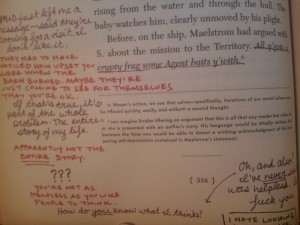 And the Jen and Eric characters were so unbelievably bad they might as well have come from a Nickelodeon series. There’s just no attempt at making them human at all. On one page she’s saying “fuck you” to him and the next page they’re all good. Jen come across as such a twat at the start of the book why would any guy want to talk to her without seeing her face first? Eric comes across like such a douchebag what girl would want to keep talking to him? Are these two so desperate for an interaction they’ll carry on this ridiculous set of circumstances? Why the hell would these two carry out their relationship in the margins of this book? It’s obvious that they hook up at some point and travel away together. So then why are they still using the book to talk to each other? Are they in bed together, jotting stuff down then handing it back and forth? The lovey-dovey banter between the two is so unreadable that I wanted to spit on the pages.
And the Jen and Eric characters were so unbelievably bad they might as well have come from a Nickelodeon series. There’s just no attempt at making them human at all. On one page she’s saying “fuck you” to him and the next page they’re all good. Jen come across as such a twat at the start of the book why would any guy want to talk to her without seeing her face first? Eric comes across like such a douchebag what girl would want to keep talking to him? Are these two so desperate for an interaction they’ll carry on this ridiculous set of circumstances? Why the hell would these two carry out their relationship in the margins of this book? It’s obvious that they hook up at some point and travel away together. So then why are they still using the book to talk to each other? Are they in bed together, jotting stuff down then handing it back and forth? The lovey-dovey banter between the two is so unreadable that I wanted to spit on the pages.
But I powered through this thing thinking that something was going to get resolved and all the loose ends would be tied up.
Nope, the ending resolves nothing. It’s like a television series got cancelled and they just had to throw an ending together.
“Alright, here’s the showdown….what? We’re out of money. Okay, uh, you guys decide that you’re just gonna walk away and do nothing. Bing bang done!”
Did you ever see that series The Prisoner? Well, when I first watched it I thought the ending was kinda cool. The ending was basically saying, “this show isn’t about why he resigned from his government position, this show is about him having the right to not say why he resigned from his government position.” And that was fine at the time for me. But now I think back on it and I ask why would you set this whole journey up for something that can be said in one episode? The problem that I have with S. and The Prisoner is that if you’re going to set up a mystery you should damn well solve it. Your main intention can come across and your implied goal can get accomplished just as easily while still resolving the conflict.
Let me tell you what I did when I read that last page. I slammed the book closed, stuffed it back into it’s stupid slip case, threw the book on the ground and I kicked the living shit out of it.
You mother fucking piece of god damn garbage. You waste of fucking time. You snooty piece of trash.
Dear J.J. Abrams and Doug Dorst,
You have the audacity to call your book a piece of art and an homage to the written word that’s meant to be held? Then you sling together this unsatisfying, clunky, messy, disjointed, repetitive, load of dreck? Who are you trying to fool? People that have never read a book in their life? At least I can say that I’ve been spared the torment of ever having to mistakenly read a book by Doug Dorst and watch anything associated with J.J. Abrams again.
Do not waste your time with this book. Spend your money on going to Chuck E. Cheese instead. Spend your money on carpet samples. Spend your money on anything except this horrendous excuse for literature.
